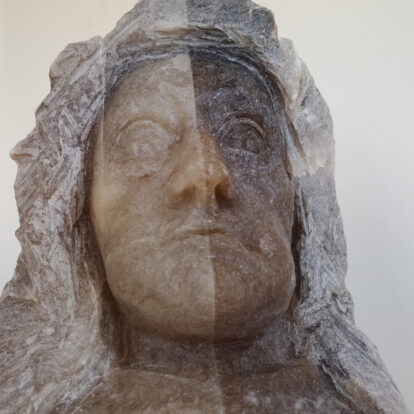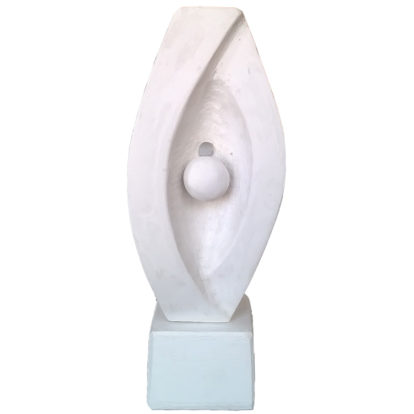
Francisco.
Madera.
Cm 35*30*10.
Síndrome de Crouzon.
Es una enfermedad genética causada por mutaciones del receptor del factor de crecimiento de fibroblastos FGFR2, caracterizada por craneosinostosis e hipoplasia facial. La craneosinostosis es variable, pero suele afectar a varias suturas. La dismorfia facial se caracteriza por hipertelorismo ocular, nariz pequeña y picuda, proptosis, exoftalmos, hipoplasia maxilar y prognatismo mandibular.
La sinostosis es progresiva y, por lo general, no es visible o sólo es ligeramente visible al nacimiento. Suele manifestarse a la edad de 2 años y se vuelve progresivamente más grave. Sin embargo, se han descrito formas precoces y congénitas en las que la hipoplasia del maxilar superior es pronunciada y provoca dificultades respiratorias, y la exoftalmía es grave y resulta en maloclusión palpebral. La hidrocefalia, el descenso de las amígdalas cerebelosas y las anomalías del drenaje venoso de cabeza y cuello también se observan con frecuencia en la enfermedad de Crouzon y pueden plantear problemas terapéuticos. Dos tercios de los pacientes con enfermedad de Crouzon presentan hipertensión intracraneal, lo que puede provocar ceguera.
Las intervenciones quirúrgicas tienen como objetivo prevenir las complicaciones cerebrales, oftalmológicas o respiratorias y corregir la dismorfia cráneo-facial. El abordaje quirúrgico craneofacial adoptado debe tener en cuenta tanto la sinostosis craneal como la facial y debe adaptarse a cada paciente.
Sinónimos: Disostosis craneofacial de Crouzon.
Prevalencia: 1-9 / 1 000 000.
Herencia: Autosómica dominante.
Edad de inicio o aparición: Lactancia, Neonatal.
Francisco.
Wood.
Cm 35*30*10.
Crouzon syndrome.
It is a genetic disease caused by mutations in the fibroblast growth factor receptor FGFR2, characterized by craniosynostosis and facial hypoplasia. Craniosynostosis is variable, but usually affects several sutures. Facial dysmorphism is characterized by ocular hypertelorism, small and pointed nose, proptosis, exophthalmos, maxillary hypoplasia and mandibular prognathism.
Synostosis is progressive and is usually not visible or only slightly visible at birth. It usually becomes apparent by the age of 2 years and becomes progressively more severe. However, early and congenital forms have been described in which maxillary hypoplasia is pronounced and causes respiratory difficulties, and exophthalmos is severe and results in eyelid malocclusion. Hydrocephalus, descent of the cerebellar tonsils, and abnormalities of venous drainage of the head and neck are also frequently seen in Crouzon disease and may pose therapeutic problems. Two-thirds of patients with Crouzon disease have intracranial hypertension, which may lead to blindness.
Surgical interventions are aimed at preventing cerebral, ophthalmological or respiratory complications and correcting craniofacial dysmorphism. The craniofacial surgical approach adopted must consider both cranial and facial synostosis and must be adapted to each patient.
Synonyms: Crouzon craniofacial dysostosis.
Prevalence: 1-9 / 1,000,000.
Inheritance: Autosomal dominant.
Age of onset or appearance: Lactation, Neonatal.







